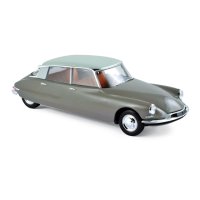DS 19 OPERATION No. DS 314-0 : Checking and adjustments on the clutch control. Op. DS 314-0 169
TOOLS
CHECKING A CLUTCH CYLINDER FOR LEAKAGE (see Pl. 49).
1 In order to carry out this operation, prepare a long pipe by connecting the pipes (A) and (B) (see Pl. 173) and
prepare the test bench as indicated on Pl. 171 . . . . . . . . . . . . . . . . . . . . . . . . . . . . . . . . . . . . . . . . . . . . . . . . . . Test Bench 2290-T
2 Release the pressure in the clutch system by operating the auxiliary clutch control.
3 Disconnect the pressure feed pipe from the clutch cylinder.
Connect the pipe (B) on the clutch cylinder, place the test bench by the side of the car and connect the end of
the pipe (A) to the pump orifice “a” (bend the pipe if necessary).
4 Tighten the bleed screw “b” of the test bench and operate the pump in order to build up pressure. Unscrew the
bleed screw “b” in order to bleed the system. Carry out this operation three times, then build up the pressure
to 1070 p.s.i. (75 kg/cm
2
). The pressure gauge (MI) should indicate no drop in pressure, if so, the joint or
piston assembly is defective.
CHECKING THE CLUTCH (see Pl. 49).
NOTE - This operation is carried out only
When the engine frequently stalls when braking, even if the slow running and clutch are properly adjusted.
When the gears “crash” when engaging.
5 In order to carry out this operation, prepare a long pipe by connecting the pipes (A) and (B) (see Pl. 173) and
prepare the test bench as indicated on Pl. 171 . . . . . . . . . . . . . . . . . . . . . . . . . . . . . . . . . . . . . . . . . . . . . . . . . . Test Bench 2290-T
6 Release the pressure in the clutch system by operating the auxiliary clutch control.
7 Disconnect the pressure feed pipe from the clutch cylinder.
Connect the pipe (B) on the clutch cylinder, place the test bench by the side of the car and connect the end
of the pipe (A) to the pump orifice “a” (bend the pipe if necessary). Tighten the bleed screw “b”.
8 To check the clutch pressure.
Put the starting handle in position, fitted with a socket 14 mm across flats and a torsion spanner (torsion spanner
2471-T, see Pl. 7, fig. 2).
Exert a pressure of 10.8 ft/lbs (1.5 m.kg) on the starting handle in order to turn the engine.
While maintaining this pressure, have the pump operated by an assistant, so as to gradually raise the pressure
in the clutch cylinder.
Note carefully the pressure at which the clutch is disengaged, (the moment when the handle can be turned
without turning the engine). With a pressure of 7.2ft/lbs (1 m.kg), this pressure should be less or at the most
equal to 425 p.s.i. (30 kg/cm
2
).

